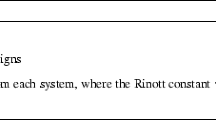Abstract
Conventional geostatistical simulation methods are implemented in a way that is inherently gridded and sequence dependent. A variant of spectral simulation method is revisited from a linear model of regionalization standpoint to simulate realizations of coregionalized variables that are expressed as a function of the coordinates of the simulation locations, data values, and imposed spatial structure. The resulting grid-free simulation (GFS) methodology expresses a realization at any set of regularly or irregularly distributed nodes. GFS consists of two main steps: unconditional grid-free simulation and dual cokriging-based conditioning. The unconditional multivariate simulation is represented by a linear model of coregionalization, where weights are derived from the covariance function of the modeled system, and random factors are computed as a sum of equally weighted line processes within a turning bands paradigm. These stochastic line processes are expressed as a linear model of regionalization, weights are from the Fourier series decomposition of line covariance functions, and random factors have a cosine function form requiring coordinates of simulation locations and the random phases. The resulting conditionally simulated values are uniquely tied to simulation locations by an analytical form. Newly assimilated data change current realizations only locally within the correlation range. The GFS parameters are carefully chosen from a series of examples, and the associated theory is illustrated with a three-dimensional case study.



















Similar content being viewed by others
References
Alabert F (1987) The practice of fast conditional simulations through the LU decomposition of the covariance matrix. Math Geol 19(5):369–386
Barnett RM, Manchuk JG, Deutsch CV (2014) Projection pursuit multivariate transform. Math Geosci 46(3):337–359
Bochner S, Chandrasekharan K (1949) Fourier transforms. Princeton University Press, Princeton
Bracewell RN (2000) The Fourier transform and its applications, 3rd edn. McGraw Hill, New York
Chiles J-P, Delfiner P (2012) Geostatistics. Modeling spatial uncertainty, 2nd edn. Wiley, New York
Cooley JW, Lewis PAW, Welch PD (1969) The fast Fourier transform and its applications. IEEE Trans Educ 12(1):27–34
Coxeter HSM (1940) Regular and semi-regular polytopes. I. Math Z 46(1):380–407
Davis MW (1987) Production of conditional simulations via the LU triangular decomposition of the covariance matrix. Math Geol 19(2):91–98
Deutsch CV, Journel AG (1998) GSLIB: geostatistical software library and user’s guide, 2nd edn. Oxford University Press, New York
Emery X, Lantuejoul C (2006) TBSIM: a computer program for conditional simulation of three-dimensional Gaussian random fields via the turning bands method. Comput Geosci 32(10):1615–1628
Freulon X, de Fouquet C (1991) Remarques sur la pratique des bandes tournantes a 3D. Cahiers de Gostatistique, Fascicule 1, Compte-rendu des Journes de Gostatistique, Fontainebleau, pp 101–117
Goovaerts P (1997) Geostatistics for natural resources evaluation. Oxford University Press, New York
Gneiting T (1998) Closed form solutions of the two-dimensional turning bands equation. Math Geol 30(4):379–389
Hassanpour RM (2013) Grid-free facies modelling of inclined heterolithic strata in the McMurray formation. Ph.D. Thesis, University of Alberta
Journel AG (1974) Geostatistics for conditional simulation of ore bodies. Econ Geol 69(50):673–687
Journel AG, Huijbregts CJ (1978) Mining geostatistics. Academic Press, New York
Leuangthong O, Deutsch CV (2003) Stepwise conditional transformation for simulation of multiple Variables. Math Geol 35(2):155–173
Mantoglou A, Wilson JL (1982) The turning bands method for simulation of random fields using line generation by a spectral method. Water Resour Res 18(5):1379–1394
Oliver DS, Reynolds AC, Liu N (2008) Inverse theory for petroleum reservoir characterization and history matching. Cambridge University Press, New York
Pardo-Iguzquiza E, Chica-Olmo M (1993) The Fourier integral method: an efficient spectral method for simulation of random fields. Math Geol 25(2):177–217
Pardo-Iguzquiza E, Chica-Olmo M (1994) Spectral simulation of multivariable stationary random functions using covariance Fourier transforms. Math Geol 26(3):277–299
Press WH, Teukolsky SA, Vetterling WT, Flannery BP (1997) Numerical recipes in Fortran 77, vol 1, 2nd edn. Press Syndicate, Cambridge
Pyrcz MJ (2004) Integration of geologic information into geostatistical models. Ph.D. Thesis. University of Alberta
Pyrcz MJ, Deutsch CV (2014) Geostatistical reservoir modeling, 2nd edn. Oxford University Press, New York
Shinozuka M, Jan C-M (1972) Digital simulation of random processes and its applications. J Sounds Vib 25(1):111–128
Shinozuka M, Deodatis G (1991) Simulation of stochastic processes by spectral representation. Appl Mech Rev 44(4):191–204
Sneddon IN (1951) Fourier transforms. McGraw-Hill Book Company Inc., New York
Stewart GW (1998) Matrix algorithms: basic decompositions, vol 1. University of Maryland, College Park
Strebelle SB, Journel AG (2001) Reservoir modeling using multiple-point statistics. SPE Annu Tech Conf and Exhib, Orleans
Wackernagel H (2003) Multivariate geostatistics, 3rd edn. Springer, Berlin
Wenninger MJ (1975) Polyhedron models for the classroom, 2nd edn. The National Council of Teachers of Mathematics Inc, Virginia
Wikramaratna RS (1989) ACORN—a new method for generating sequences of uniformly distributed pseudo-random numbers. J Comput Phys 83(1):16–31
Wikramaratna RS (2010) Theoretical and empirical convergence results for additive congruential random number generators. J Comput Appl Math 233(9):2302–2311
Acknowledgments
We would like to thank the sponsoring company members of the Centre for Computational Geostatistics (CCG) for financial support, and anonymous reviewers for their valuable comments and contributions that helped to improve quality and readability of the manuscript.
Author information
Authors and Affiliations
Corresponding author
Rights and permissions
About this article
Cite this article
Zagayevskiy, Y., Deutsch, C.V. Multivariate Geostatistical Grid-Free Simulation of Natural Phenomena. Math Geosci 48, 891–920 (2016). https://doi.org/10.1007/s11004-016-9656-8
Received:
Accepted:
Published:
Issue Date:
DOI: https://doi.org/10.1007/s11004-016-9656-8




